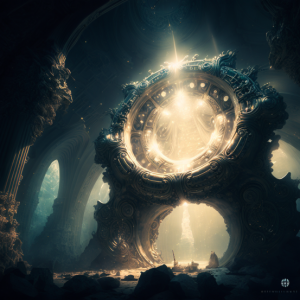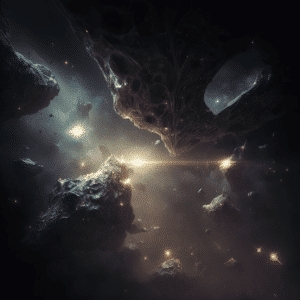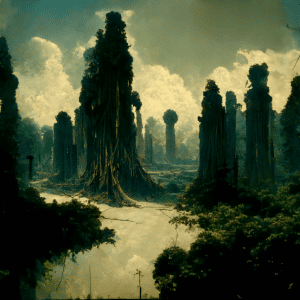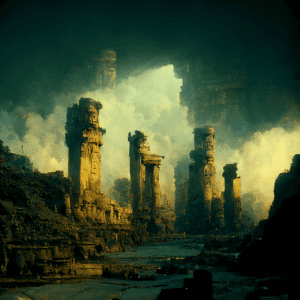Illidreth
Mean Distance from Oma: 223 WA
Orbital Period around Oma: 28 days
Mean Diameter: 1,826 miles
Length of day: 6.5 hours
Gravity: 0.3 Ethems
Description:
Illidreth is a small, cold Fekxtah that is found deep in the expanse of Seekrem’s Halo. It is not large enough to be considered a Fekxtah planet, but neither is it small enough to be considered nothing more than a piece of debris or a large asteroid.
Illidreth is an egg-shaped object. It measures slightly more than 1,800 miles at its longest and roughly 1,300 miles in its middle. It is made entirely from metals all of which are extraordinarily strong and dense. Even heavy rock, such as granite, is missing from this tiny Fekxtah.
The surface of Illidreth looks “a bit like a piece of dark mud that has been roughly worked by a giant’s hands” as the ancient texts say. It has crests that run across large portions of its body that look like an ocean wave that was frozen in place as it reached its crest. Some of these peaks can be quite sharp and run for hundreds of miles along Illidreth’s length. Though there are patches where the surface is coarse, most is smooth, almost glossy, and reflects the distant light of Oma.
The ancient texts tell us that finding a “path” to Illidreth was difficult because of its shiny metal surface and the strange Energetic patterns that are emitted from it, that extend thousands of miles into distant space. This metal object is composed almost entirely of Physic Energy, and of that kind of Physic that makes itself into the hard, impenetrable metals we have discussed.
Though the ancient texts were unsure of this and only offered hypotheses from a small number of scientists, it is believed that as one explores deeper into the interior of this object, the type of metal becomes harder and more compact. Speculation is that Illidreth had been the dense core of a much larger Fekxtah millions of years ago, and that the Fekxtah had been destroyed through forces inconceivable to the Elzheni or to ourselves. One of the things it left behind by the catastrophic event was this fragment of its core. It is also proposed that much of the detritus of Seekrem’s Halo comes from tiny fragments of this ancient Fekxtah behemoth.
The ancient Elzheni had a strong interest in Illidreth for two reasons. The first was that it offered them, potentially, great knowledge about materials that are fundamentally different from any to be found on our own home Fekxtah planet Ethem. Not long before their destruction the Elzheni were engaged in efforts to drill down into the utmost core of Ethem; however, we have no texts that talk of the details of that project, so we have almost no understanding of what knowledge the Elzheni gained from it.
The other reason the Elzheni had an interest in Illidreth was because of how it radiated pure Physic Energy from its body. These invisible tendrils of pure Physic Energy extended thousands of miles out from Illidreth, and the force of these Energetic lines created a complex system of Energy streams whose effect could be felt throughout much of Seekrem’s Halo. It was a great challenge for the Elzheni scientists to understand these streams and their ever changing paths, but it also had the potential to enormously deepen their understanding of the Six Energies, and Physic Energy in particular. There are also footnotes in the ancient texts that mention efforts to “ride” these streams to travel through Seekrem’s Halo, but it was a highly dangerous endeavor.
Constructing the Fekxtah Station on this object was a great challenge even for the Elzheni. However, as we know is the way with the Elzheni once they set themselves a goal, they find a way, and so they did with the Fekxtah Station, which we will describe in greater detail below.
There was another task, though, that the Elzheni set for themselves which was equally as difficult. An Elzheni scientist by the name of Chelhanna believed that the powerful, invisible, tendrils of Physic Energy that extended out from Illidreth could be used to create a device that could be used to research other objects in Seekrem’s Halo, and perhaps in Oma’s larger family. This led to a project over fifteen years, led by Chelhanna, to construct this device on Illidreth. It was called Illidreth’s Reflector, or Energy Reflector, because it was able to capture, and reflect, the Physic Energy from other objects at great distances.
Fekxtah Station #14:
As mentioned, the creation of a Fekxtah Station on Illidreth was a particular challenge, even to the powerful capabilities of the Elzheni scientists. It was extremely difficult to drill into the strong metal surface of Illidreth, even using Energetic tools that the Elzheni had used on Ethem to great effect. The ancient texts state that even when progress had been made, and a hole was created, the hole would within days, and sometimes hours, fill itself back in. It was as if Illidreth itself wanted to maintain its shape and resisted any attempt to change it.
Eventually all attempts to drill into the tiny Fekxtah were abandoned. The Elzheni next tried to reshape surface material to raise it up into walls and roofs. These attempts met the same fate, and were also abandoned. Finally, material from Ethem was brought to Illidreth to construct the Fekxtah Station. This, too, had difficulties as most materials would refuse to adhere to Illidreth’s surface and soon drifted away into the dark reaches of space, often carried by one of the Energy Tendrils. After many attempts, the Elzheni did find materials that were able to establish an Energetic attachment to Illidreth’s surface and that lasted. In fact, the ancient texts tell us that, “Illidreth not only accepted these materials from Ethem, but seemed to be attracted to them, and drew them to bind with Illidreth’s normal surface metals.”
The construction of Illidreth’s Reflector was another matter. To construct this large device, the Elzheni brought small metal objects that floated in Illidreth’s proximity as the base material for shaping and building the Reflector. Even more amazing was the ability of the Elzheni to position the Reflector so that it could control the direction and extent of the Energetic Tendrils emanating from Illidreth’s form. Unfortunately, the ancient documents in our possession mention little details about the Reflector. They talk about an immensely complex control room that is a part of the Reflector, but other than that mention they only refer us to other documents which we do not now have in our possession.






